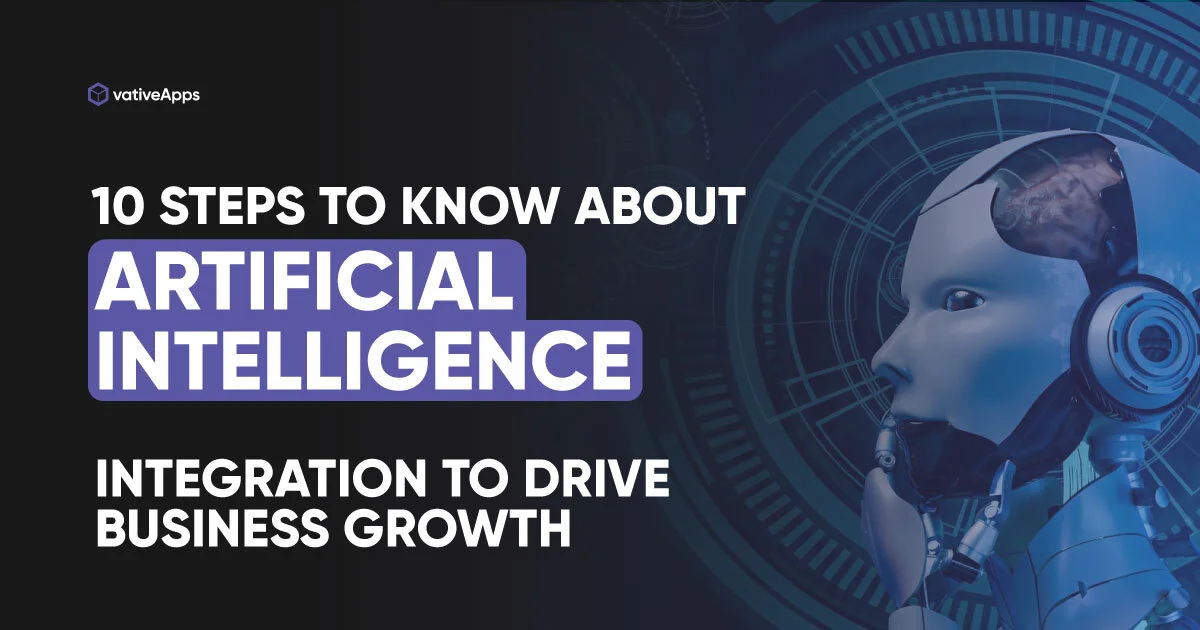
Artificial Intelligence (AI) has emerged as one of the most transformative technologies of our time. From personal tasks to professional responsibilities.
AI tools can be customized to meet organizational needs, establishing businesses to organize processes and boost efficiency. However, before incorporating AI into your operations, it’s important to understand its inner workings, including the opportunities it presents and the challenges it may pose.
Artificial Intelligence (AI) is transforming businesses worldwide, automating processes, improving decision-making, and upgrading customer experiences. For organizations looking to stay competitive, integrating AI into their operations is essential. This comprehensive guide outlines 10 steps to know about artificial intelligence integration that can help you achieve business growth effectively and efficiently.
The Role of AI in Modern Business
AI is no longer an innovative concept; it’s a reality shaping the present and future of industries. Companies that adopt AI solutions see benefits in operational efficiency, cost reduction, and innovation. However, the integration of artificial intelligence into a business requires careful planning and execution.
Step 1: Explain Your Business Goals for AI Integration

Before integrating AI into your business, it’s important to define your specific goals and objectives. Start by discovering the challenges AI can address, such as well organized operations, improving customer experiences or decision-making.
Consider how AI can optimize existing processes and contribute to achieving your long-term business vision. Clear goals will serve as a foundation for determining the right AI tools and strategies to implement, verifying measurable results and encouraging growth.
Step 2: Assess Your Current Data Arrangements
To check successful integration of artificial intelligence, start by assessing your current data arrangement. AI systems depend on accurate, well-organized, and accessible data to deliver meaningful results. Evaluate the quality, quantity, and availability of your data, as well as the systems in place for storing and processing it.
Identify any gaps or limitations, such as outdated technology, inconsistent data formats, or insufficient data security measures. Boosting your data framework is a critical step to allow AI solutions to function effectively and create valuable insights.
Step 3: Identify Use Cases for AI in Your Business
Identify particular use cases where AI can make an essential impact on your business operations and outcomes. Concentrate on areas where AI can solve problems, manage workflows, improve customer experiences, or unlock new revenue opportunities.
Whether it’s automating repetitive tasks, providing insights, or customizing offerings, selecting high-value use cases which make sure a targeted and effective AI implementation.
Step 4: Partner with Trusted AI Integration Services
Collaborating with trusted Artificial Intelligence integration services is key to a successful execution. Experienced partners can guide you through the process, from selecting the right tools to customizing solutions for your specific requirements. Their expertise provides smooth integration, reduces risks, and drives the selection of AI technologies, helping you achieve your business goals perfectly.
Step 5: Develop a Pilot Program
Start with a pilot program to test AI on a smaller scale, allowing you to identify its effectiveness and address potential challenges. Use the insights gained to refine the solution before scaling it across your organization.
Step 6: Train Your Team for AI Adoption
Artificial intelligence integration requires both technology and people working in symmetry. Deliver your team with the necessary training and support to establish their confidence in using AI systems and adapting to new workflows.

Step 7: Integrate AI with Existing Systems
It’s crucial to make sure AI solutions are smoothly integrated into your existing workflows to maintain operational continuity. Consider minimizing disarrangement while optimizing processes to support the full potential of AI.
Step 8: Monitor AI Performance and Repeat
Regularly check the performance of your Artificial Intelligence solutions to make sure they meet your business objectives. Utilize data from this evaluation to fine-tune and optimize the systems for ongoing improvement.
Step 9: Scale AI Solutions Across Your Organization
After a pilot program, increase AI implementation to other areas of your business. Scaling strategically ensures consistent results and increases the value of your AI venture.
Step 10: Prioritize Ethical and Responsible AI Use
Accept AI comes with ethical considerations, such as data privacy, fairness, and transparency. Establish guidelines to check responsible use, raise trust and align AI practices with your company’s values.
The Benefits of Artificial Intelligence Integration
Businesses that support artificial intelligence integration can achieve:
Enhanced Efficiency: Automate repetitive tasks and improve productivity.
Better Decision-Making: Influence data-driven insights for strategic planning.
Cost Reduction: Minimize operational costs through smart automation.
Improved Customer Experience: Provide personalized and timely support.

Challenges of AI Integration and How to Overcome Them
High Costs: Start small and focus on high-impact areas to handle expenses.
Resistance to Modify: Involve employees in the process and provide suitable training.
Data Privacy: Partner with AI integration services that prioritize submission and security.
Conclusion

The integration of artificial intelligence is no longer optional for businesses seeking to stay in demand. By following these 10 steps to know about artificial intelligence integration, you can open new chances, drive better results, and advance innovation in your organization. You can consider the artificial intelligence integration company and take the next big step for market growth. For more guidance and relavent topics visit at vativeapps Insights or contact us.




